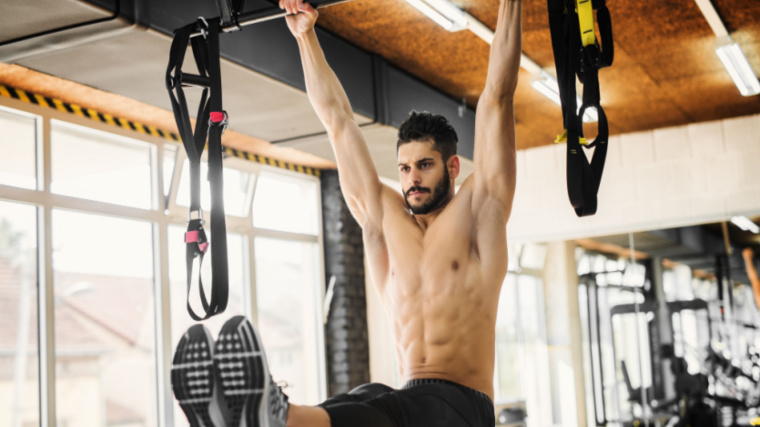You’ve labored for years to be able to do a solid strict pull-up, and — finally — one of the toughest bodyweight moves is coming easily to you. You’re ready to up the ante, but you’re not quite sure how. If you’re looking for a pull-up progression that will roast your core along with your upper back, search no more — you’ve found the L-sit pull-up.
This exercise does exactly what its name suggests. It combines an L-sit with a pull-up, such that you’re maintaining an L-shape with your body throughout your entire set of pull-ups. You’ll start by performing a controlled hanging leg raise from a dead hang, bringing your straight legs up to parallel with the ground. Then, you’ll do your pull-ups as normal — while your core maintains those parallel legs.

It’s an evil progression, to be sure, but one that is well-worth the time and energy. From better overhead mobility to increased isometric strength, check out these top benefits of adding the L-sit pull-up to your repertoire.
Benefits of the L-Sit Pull-Up
- Core Strength and Stability
- Body Control and Awareness
- Increased Isometric Strength
- Greater Time Under Tension
- Overhead Mobility
- Scapular Stabilization
- Gymnastics Carryover
Core Strength and Stability
The L-sit movement alone is a powerful core exercise that demands midline stability and strength from your abdominals and obliques. When combined with a strong pulling movement like the pull-up, you must lock (brace) your core similar to other heavily loaded movements — think, squats and deadlifts.
This gives you a lot of practice building intense midline stability without strain on your spine from heavy loads. You’ll have to control your legs, abs, and upper body isometrically to stay in control and create focused movement upwards.
Body Control and Awareness
The ability to contract and control your body in space without losing tension in your core is key to most athletic moments in the gym and in life. The L-sit pull-up can help you develop a greater understanding of your body in space to enhance overall movement and mind-muscle connection. The more coordinated you are, the more efficient your complex barbell lifts can become. Think about the necessity of understanding your own body in relation to equipment during a snatch.
Increased Isometric Strength
Gaining strength is not only about pressing, pulling loads from the ground, or squatting heavy. While those are very important parts of strength development, they do not specifically target isometric strength qualities without specific modifications. Isometric training, such as with L-sit pull-ups, skyrockets both strength and stability at the same time.
You’ll increase your core’s ability to hold a strong isometric contraction, which can easily become a limiting factor when you’re trying to deadlift or squat very heavy. If your core loses positional integrity, those lifts are going nowhere fast. Building your isometric strength without load will help a lot when you are under load.
Greater Time Under Tension
Time under tension refers to the amount of time a muscle unit is asked to generate force. The more time your muscles spend under tension, the better your muscle-building potential becomes. For lifters and athletes who rely on force development of their core, lats, and arms for prolonged periods of time, the L-sit pull-up could be a good option to develop muscular strength, size, and sports-specific performance.
Overhead Mobility
In order to keep a stable dead hang at the bottom of your L-sit pull-up, you actually need a lot of overhead mobility. You need a certain level of thoracic mobility and shoulder mobility to move through any type of pull-up without compensation patterns or potential pain. The L-sit pull-up helps you hone this overhead mobility, with the added challenge of keeping your hips in position with the L-sit, too.
Scapular Stabilization
All the shoulder mobility in the world won’t help you with heavy overhead squats and snatches if it’s not balanced with the ability to stabilize your shoulders. Even as the L-sit pull-up will help you build better overhead mobility, it will also help you develop the scapular stability you’ll need to keep yourself steady throughout the lift.
You’ll need to counterbalance your legs by keeping your upper body stable and moving straight up and down (instead of wobbling a lot during the movement). That increased demand on your shoulders will help you increase your overall scapular stability, which can carry over into a wide range of overhead lifts.
Gymnastics Carryover
You don’t have to be a gymnast to want to get better on rings, bars, and parallettes — though you certainly can be. CrossFitters, too, can benefit tremendously from getting stronger and more efficient on these implements. From muscle-ups and kipping pull-ups to chest-to-bar pull-ups and toes-to-bar, the strength, stability, and mobility you’ll train with L-sit pull-ups can carry over into more dynamic, explosive gymnastics-style movements.
How to Do the L-Sit Pull-Up
To perform the L-sit pull-up, you’ll need to master both of its components — the L-sit and the pull-up. You’ll want to be able to comfortably hold an L-sit from a hanging position for at least 30 seconds and to be able to do at least 10 to 15 strict pull-ups per set. Then, put these moves together as follows:
- Hop up to grab a pull-up bar with your preferred grip. Settle into a dead hang.
- Pull your shoulders down and away from your ears to engage your upper back.
- Perform a controlled hanging leg raise to bring your straight legs up to parallel with the floor.
- Stabilize your position until any wobbling subsides.
- Keep your core and upper back engaged as you exhale all your air. Brace your core and take a deep breath into your belly.
- Perform a strict pull-up, keeping your legs in their L-sit position. Exhale and take a quick inhale as your chin clears the bar.
- Lower under control.
- Reset your position and repeat for reps.
Make sure you don’t hold your breath throughout your set, instead breathing in a similar way to how to take your breaths during other braced movements like squats.
L-Sit Pull-Up Variations
Whether you’re not yet able to do an L-sit pull-up or have mastered them and are looking for a similarly core-strengthening variation, you’ve come to the right place.
Eccentric Pull-Ups
If you’re struggling with the pull-up component of this lift, practice eccentric pull-ups to help you build positional strength and good form. Jump up — use a step or plyo box to help make this more accessible — to hold your chin above a pull-up bar and sink back down to a dead hang as slowly as you can.
This might seem very fast at first, but practice will help you slow your descent more and more. Once you’ve built enough strength, you can harness it into a full pull-up.
Hanging Leg Raises
Although hanging leg raises involve dynamic core movement instead of an isometric, you’ll still be practicing the art of keeping your lower body still. That’s harder than it might seem when you’re trying to make as much movement as possible come from your core.
To make this move more challenging, add an isometric hold at the top of each rep. Lower your legs very slowly to build as much eccentric strength as possible.
Toes-to-Bar
Once you’ve got the L-sit pull-up down, you might be on the hunt for something a bit more explosive. The toes-to-bar move fits that bill pretty nicely.
Instead of maintaining an isometric, you’ll start developing explosive power with your core to hike your toes all the way up to the bar. This won’t just come in handy during CrossFit WODs (workouts of the day) — it’ll also be useful for athletes who need to put their core strength in dynamic action, like football players and wrestlers.
Chest-to-Bar Pull-Up
The chest-to-bar pull-up focuses a bit more on upper back explosivity than core explosivity, but you’ll still be developing a hefty degree of both. You’ll often kick this exercise off with a kipping move, which requires a lot of core strength and upper body mobility.
In that way, the chest-to-bar pull-up will help you develop a lot of the same qualities as the L-sit pull-up. These just have a much more explosive nature and a very different appearance.
L-Sit Pull-Up Form Tips
Mastering the L-sit on its own is a challenge. So is getting the pull-up down. Putting them together is even tougher. Here are some form tips to help keep you on your game.
Emphasize Your Core
This one might seem obvious, but when you’re fatigued — or learning a challenging new movement — it’s easy to unconsciously use your hip flexors and legs instead of relying on core strength. Make sure the isometric contraction is coming from your core by bearing down on your abs. Imagine curling your tailbone under your body.
Stabilize First
Stabilize your L-sit position before you start your pull-up. If you’re still wobbling or settling into your starting position, you’ll have a much harder time with the pull-up. Being patient with your starting position will also help you maximize your upper back recruitment instead of tempting you to yank with your arms to compensate for the swaying. If you need to, linger in L-sit holds before fully progressing into L-sit pull-ups.
Breathe
It might be tempting to hold your breath during this move — or, you might straight-up forget to breathe. Aim to breathe during your sets. To do so, establish your L-sit position, then exhale all the air from your lungs. Squeeze your core, then — keeping your core muscles contracted — take a big inhale through your belly.

[Read More: The Best Upper Body Exercises and Workouts]
Continue those core-contracted belly breaths throughout your set, exhaling at the top and giving yourself a quick inhale, too. If you need to, grab an extra breath as you reset in the dead hang position.
Programming the L-Sit Pull-Up
You’ll program the L-sit pull-up similarly to how you’ll program your pull-up. You might use it as an accessory on back day or after heavy deadlifts. If you’re very advanced, you might also perform a set or two toward the end of your warm-up to prime your upper back and core for heavier lifting.
Listen to your body regarding how many reps you program. With taxing bodyweight movements like this, you’re less likely to stick to traditional rep and set schemes since you can’t adjust the weight accordingly. Instead, perform two to four sets to two or three reps shy of failure. If you’re aiming to build endurance, go for the higher range of sets. When you’re looking to build strength and muscle, stick to fewer sets — but bring your reps even closer to failure.
[Read More: The Best Bodyweight Exercises, + Workouts and Tips From a CPT]
Depending on your skill and experience level, you can rest from anywhere between 45 and 90 seconds between sets. You want to push yourself but also ensure that you’ve caught your breath and are well-recovered so that you can give each set your all.
Sit Down and Pull Up
The L-sit and the pull-up are spectacular strength-builders all on their own. Combining them into an L-sit pull-up brings out previously untold benefits all into the same exercise. You’ll be skyrocketing your full-body coordination, all the while bringing your core strength to a completely new level. Learning the L-sit pull-up might require quite a bit of dedication and practice, but putting in the sweat will pay you back in spades.
Featured Image: Undrey / Shutterstock